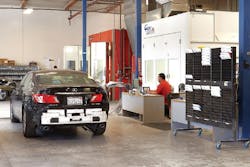The Inspiration: David Caulfield has always preached a message of transparency in his shop, Fix Auto Yorba Linda in Yorba Linda, Calif. And while he extols the use of a management system, he says it requires employees to “do homework:” physically walk over to the computer and log into the system to check the status of each vehicle.
Fix Auto Yorba Linda
Location:
Yorba Linda, Calif.
Owner:
David Caulfield
Size:
15,100 square feet
Staff:
17
Average monthly car count:
144
Annual revenue:
$3.3 million
“Even though it’s in your management system, we felt that a physical file was important for everyone to see,” he says. “When an individual logs into a system, only the individual knows the status. We needed a system in which there isn’t any homework for anybody to do.”
What it Does: Enter the rolling production board, made up of a set of 10 file racks clipped onto a frame on wheels.
Each rack is labeled with the name of a department: repair planning; authorization; body; paint; color, sand and buff; reassembly; sublet; mechanical; wash and detail; and quality control and final audit.
When a vehicle enters the shop, a file is created for the vehicle, which contains a copy of the estimate, customer check-in sheet, parts invoices, and insurance company assignment.
As the vehicle mov
es through the repair process, that file is moved from one department to the next on the production board. This alerts the next department that they can begin work on the vehicle.
“It’s public display for everyone to engage in a game of ‘hot potato’ to move the car through the repair process with a sense of urgency,” Caulfield says.
The board not only in creases communication between departments and shows what’s on deck, it also immediately highlights bottlenecks.
Caulfield notes it has also cut down on the amount of time that employees are standing around, looking for direction.
“It’s a self-coaching board: When he’s done, he moves the file,” he says. “What it does is help management keep the crew moving uninterrupted.”
How it’s Made: Caulfield purchased the file racks through Collision Services and had a local metal worker attach the racks to the frame. Caulfield decided to attach wheels to the frame
, too, so it could be moved easily around the shop.
“Currently it’s in the repair planning area,” he says. “But if they decided it doesn’t go there anymore or if we reorganize the shop floor, they can easily move it.”
The Cost: $500
The ROI: Caulfield views the production board as a piece of the puzzle: “It’s part of the formula for a program that increases hours-per-day production, reduces cycle time and enhances communication,” he says.
He says the production board is an integral part of maintaining the shop’s 6.2-day average cycle time (on an average ticket of $2,1084) and 5.6-hours-per-day touch time.
